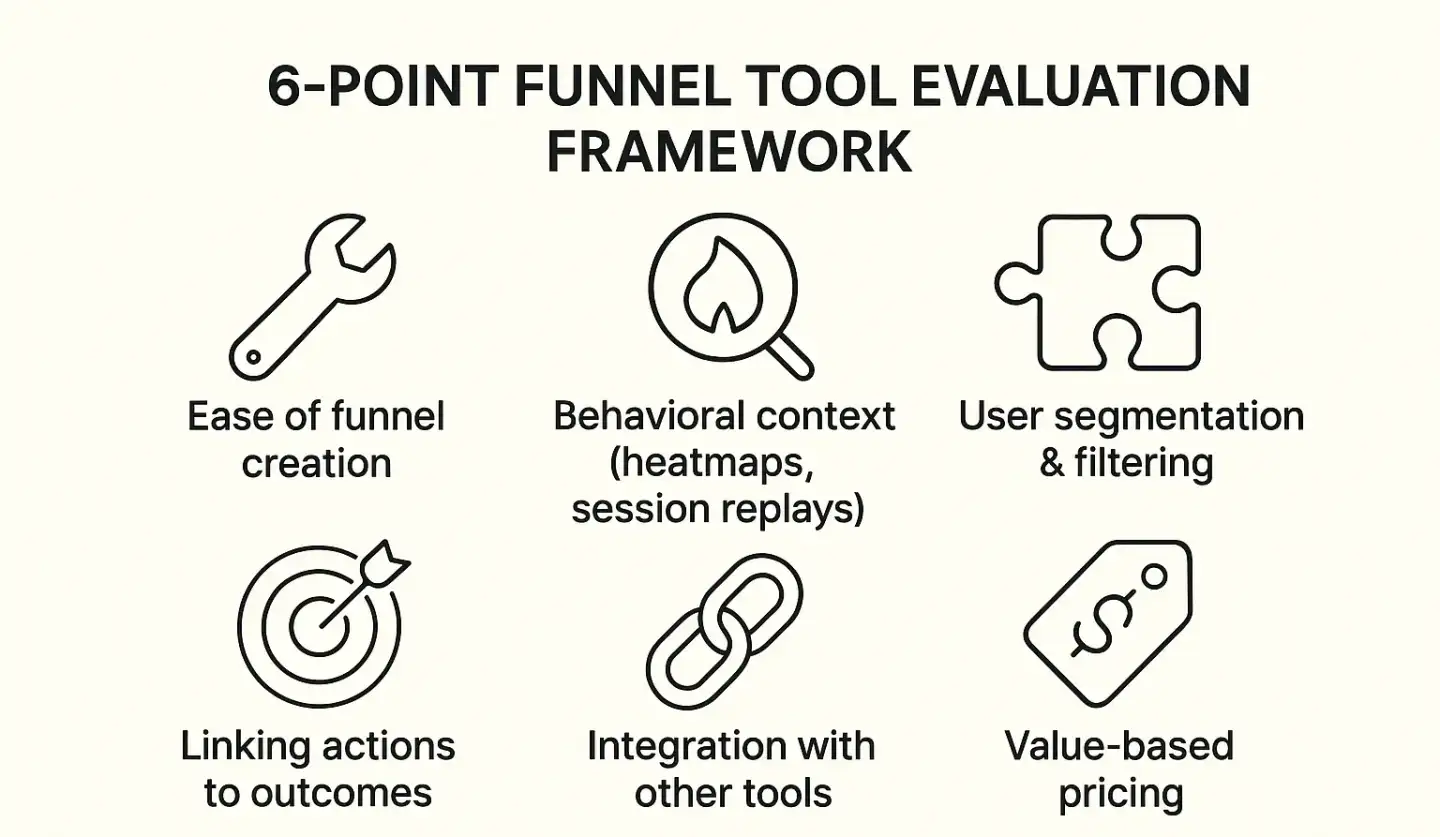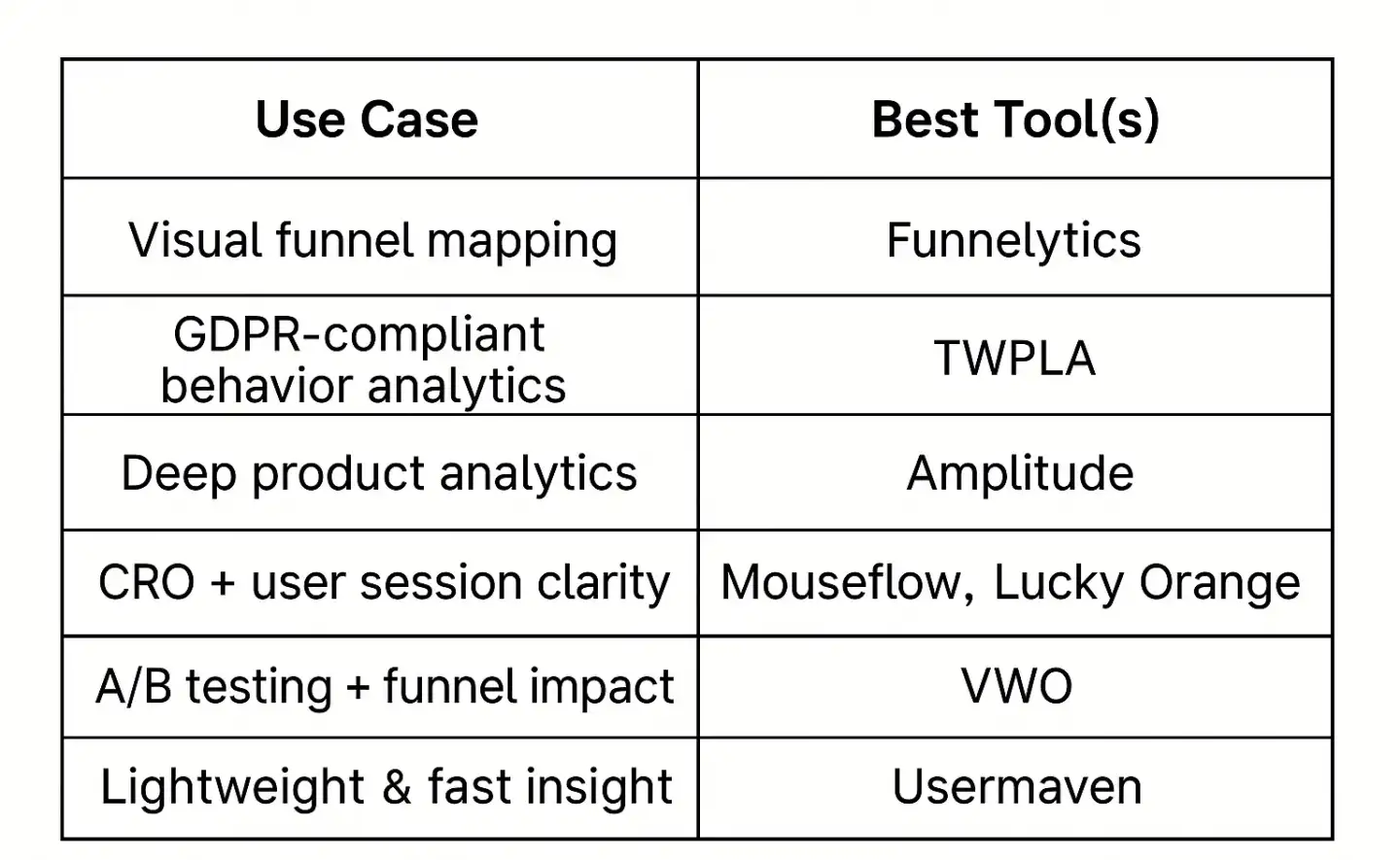We test and review software products using an independent, multipoint methodology. If you purchase something through our links, we may earn a commission. Read about our editorial process.
In today’s digital ecosystem, understanding how users move through your product, website, or marketing funnel is critical to driving growth. Whether you're trying to increase signups, improve product onboarding, or reduce cart abandonment, funnel analysis provides the clarity needed to optimize each stage of the user journey.
These tools reveal where users drop off, which touchpoints convert best, and how different segments behave at every step. In 2025, with user expectations higher than ever and multi-channel engagement the norm, relying on assumptions is no longer enough. Businesses need hard data—and the right funnel analysis tool—to uncover the truth about what’s working and what isn’t.
This guide reviews the top funnel analysis platforms and explains how each one supports smarter decision-making, better product experiences, and higher conversion rates.
Funnels help turn complex user behavior into understandable paths. They answer key questions: How many potential customers land on your site? How many sign up for a trial or demo? How many actually convert into paying customers? And crucially—where are you losing them?
In 2025, effective funnel tools go beyond traditional analytics by showing not just the what, but also the why. Integrated heatmaps, session recordings, behavioral timelines, and cohort analysis offer deeper insights into the friction users face. This level of detail is especially vital in environments where one lost click can cost thousands in revenue.
Whether you're in SaaS, eCommerce, education, or publishing, funnel analysis reveals bottlenecks and opens the door to continuous improvement.
We rely on our internal evaluation methodology, developed from years of working with marketing and product teams. Instead of relying only on feature checklists, we look at practical performance: how tools fit into real workflows, how quickly they surface meaningful insights, and how well they adapt to different team needs.

We focus on six core areas: ease of funnel creation, availability of behavioral context (like session replays and heatmaps), ability to filter by user attributes or segments, how clearly the tool links behavior to outcomes, integration depth with other platforms, and whether the pricing makes sense for the value delivered.
Now, let’s walk through the top tools that meet these standards in 2025.
Funnelytics stands out as a powerful visual tool that lets marketers sketch and monitor their funnels in real time, utilizing form data and relevant keywords to enhance their insights. The interface is built around a drag-and-drop canvas where you map out each step of a campaign—whether it’s an email flow, landing page sequence, or product onboarding journey—and track how actual users navigate those steps.
One of its strengths is the ability to overlay real traffic data onto your funnel map, providing valuable insights into your form performance and to track form submissions. This gives a clear visual sense of where people are entering, dropping off, or converting. For teams that want to plan before launching and monitor after deployment, Funnelytics delivers both strategy and insight in one place.
TWIPLA, formerly known as Visitor Analytics, brings privacy-first design to funnel tracking. The platform is built to comply with GDPR and CCPA while still providing rich user behavior data. It allows marketers to create custom funnels and track performance without using cookies.
But it’s more than just a compliant tool—it also integrates features like heatmaps, session replays, and user journey maps. This helps teams not only measure where drop-offs occur but understand the reasons behind them. TWIPLA is ideal for businesses that operate in regulated markets or want to prioritize privacy without sacrificing insight.
Amplitude is one of the most comprehensive analytics tools available for digital product teams. Its funnel analysis features are particularly robust, supporting retroactive funnel creation, cohort comparisons, and trend forecasting. This makes it invaluable for SaaS companies that need to understand how user behavior changes over time.
What sets Amplitude apart is its deep connection to product usage. You can tie funnel data to specific actions within your app or website and track how changes impact long-term retention and monetization. It’s not the simplest tool on this list, but for companies that need scale and precision, it’s among the best.
Mouseflow combines traditional funnel analysis with powerful behavioral insights like session replays, heatmaps, and form analytics. It helps teams go beyond numbers by allowing them to watch real user sessions and understand exactly what caused a user to abandon a page or a form submission, including form abandonment scenarios, and those integrated with WordPress.
This blend of quantitative and qualitative insight makes Mouseflow a favorite for UX and CRO specialists. You can identify friction points, test hypotheses, and see direct evidence of how design decisions impact user flow and user interactions, especially when using an online form. Insights into form optimization are especially useful for eCommerce and B2B sites where forms and landing pages play a central role in conversion.
VWO (Visual Website Optimizer) is known primarily as an experimentation and A/B testing platform that also runs AI-driven b tests, but it offers a funnel analysis feature that tracks how users interact with different variations. This makes it easy to evaluate how changes to design or messaging affect each step of the funnel.
For teams focused on optimization, VWO is a natural fit. You can build tests, monitor funnel impact, and adapt in real-time—all within a single platform. It’s best suited for businesses already invested in continuous experimentation as part of their growth strategy.
Lucky Orange provides an affordable all-in-one solution for small to mid-size businesses. Alongside funnel tracking, it includes live visitor monitoring, session recordings, polls, and heatmaps. Its interface is clean and approachable, making it easy to set up funnels and view drop-off points quickly, all without needing a credit card.
One unique feature is the ability to chat with users in real-time based on where they are in the funnel. This enables proactive engagement at crucial decision points and adds a customer service dimension to funnel optimization.
Usermaven is a lightweight analytics solution built for startups and lean product teams. It offers no-code funnel creation and focuses on clarity, speed, and privacy. While it may lack some of the advanced experimentation features of other tools, it makes up for it with simplicity and ease of use.
With Usermaven, you can track event-based funnels, analyze conversion performance by user cohort, and measure retention—all without a steep learning curve. It’s perfect for founders and small teams who need actionable data, fast.
Funnel analysis is more than just charting conversion rates—it’s about understanding the narrative of user behavior and making smarter decisions at every stage, including form completion and conversion. From high-traffic marketing campaigns to granular product adoption flows, these tools illuminate how users interact, where they hesitate, and why they convert (or don’t).

If you’re visually mapping campaigns, Funnelytics is a strong starting point. For privacy-focused behavior tracking, TWIPLA leads the pack. Amplitude delivers depth for product teams, while Mouseflow and Lucky Orange give you a real feel for user friction. If you’re testing constantly, VWO is the clear choice. And for simple, focused funnel tracking, Usermaven makes the process seamless.
No matter your size or niche, investing in the right funnel analytics tool means turning invisible patterns into visible progress. Start with the one that matches your workflow—and optimize from there.
Yes, when choosing a service for a marketing funnel, it is important to consider the scale of your company. The scale of your business may affect the choice of service, as smaller companies may prefer less complex and more affordable solutions.
On the other hand, larger companies may need advanced functionality and scalability to meet their growth needs and ensure efficient use of marketing resources.
When choosing a service, you need to consider the individual needs and capabilities of your business to ensure the optimal choice that will meet your goals and budget.
There are several key criteria to consider when evaluating your company's marketing automation needs. First, it's important to figure out the scope of marketing tasks and processes that need automation, including lead generation, customer engagement, and campaign performance analytics.
The level of staff and their technical knowledge should also be assessed, as the complexity and flexibility of the system should match their needs and capabilities. Also, consider integrations with your company's existing systems, such as CRM or analytics tools, to ensure seamless data sharing and workflow optimization.
Equally important is considering the scalability of the chosen system, as your company's needs may change over time. In general, a successful marketing automation needs assessment consists of carefully analyzing the processes and needs of your business to choose the optimal solution.
To test the effectiveness of the chosen service for the marketing funnel, you should first determine key success metrics such as conversion, bounce rate and ROI (return on investment). Then, you need to use the analytical tools provided by the chosen service to track and analyze these metrics.
Regularly evaluate results and compare them to initial goals and expectations. It is also useful to perform a comparative analysis with other services on the market to make sure that the chosen option suits your needs best. Do not forget to take into account user reviews and recommendations of specialists, as this can help to get an objective assessment of the service's effectiveness.